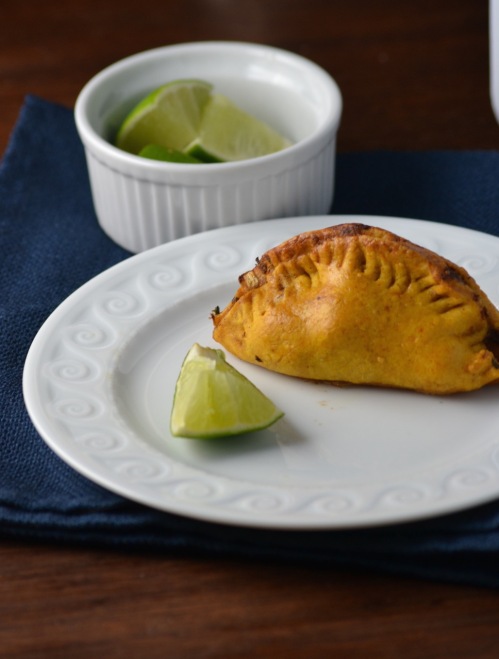
We hosted a dinner on Saturday night for a wonderful group who ate like little birds. Normally we rejoice a bit at this scenario thinking of the already prepared meal in our future, but with six large short ribs remaining the thought of short ribs for at least two, and possible three more dinners, made us lose much of our enthusiasm and left me with the question of what to do with the leftover meat.
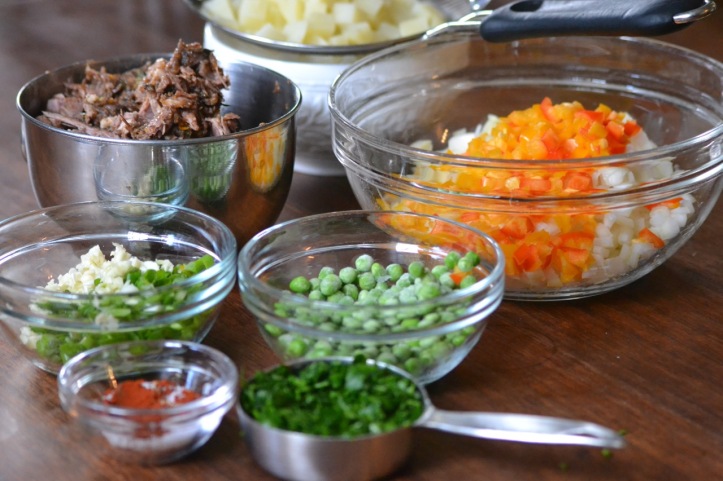
I contemplated short rib hashes, soups, and cabbage rolls before finally going back in my files for a recipe for chicken salteñas that I developed for a course on South American cooking last year. Similar to empanadas, salteñas are small meat pies that are a popular street food in Bolivia. In its most basic form, the filling in these savory pastries consists of shredded meat, potatoes, onions and spices with green peas, hard-boiled eggs, raisins, and/or green olives added based on the preference of the cook. This aromatic mixture is then wrapped in pastry dough, tinted burnt orange by the addition of achiote (also known as “annatto”) paste, and baked.

Salteñas freeze beautifully meaning that after the initial work is done a steaming salteña can be on your plate in just over thirty minutes when hunger hits. I’d never pass up a salteña for an afternoon snack or midnight nibble, but I prefer to savor one or two of them with a nice mixed green salad for dinner.

The recipe I include below is for a traditional chicken salteña. If your mouth is watering, don’t be dissuaded by the call for chicken feet. You can buy these from a local farmer or seek them out at Asian or Latin American grocery stores and their addition to your broth lends authenticity to your final product. On a side note, don’t forget to look for ground achiote and achiote paste while you are at the International grocery store as I’ve never found either ingredient at my local supermarket.
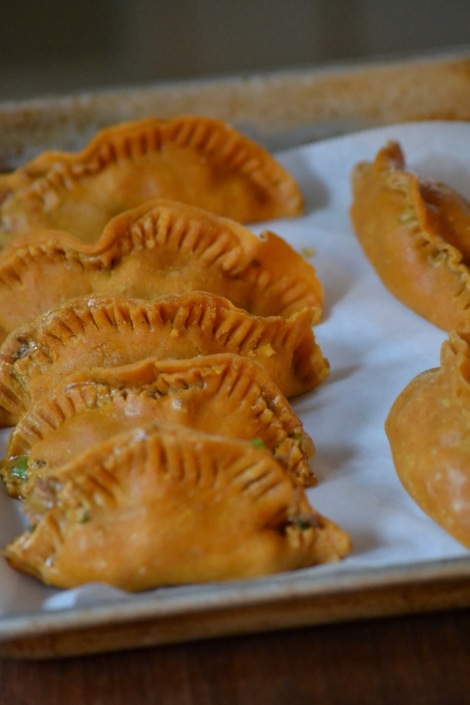
If, like me, you are seeking to merely use up leftovers ignore the call for chicken feet and simply make sure you have at least two cups of shredded meat (beef, chicken or pork) to add to the recipe when it comes time to make the filling. A gelatinous homemade stock is ideal, but if using store-bought broth be sure to purchase a less-sodium broth and reduce the amount called for in the recipe to about 1 1/2 cups.
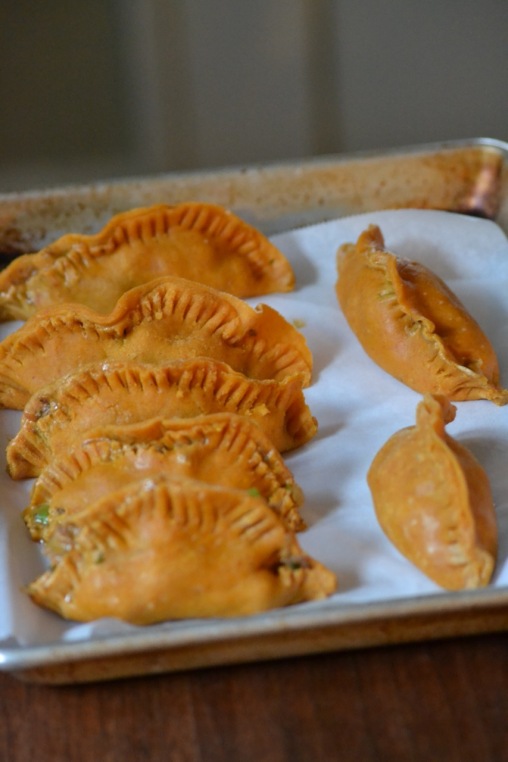
As for the other ingredients, don’t get too hung up about what you have or don’t have. I substituted yellow onions for the white onion, chopped up sweet mini-peppers instead of using a red bell pepper, and replaced the Yukon Gold potato with Russet potatoes because there was no way I was going to the grocery store. I also added a 1/2 cup of frozen peas to the mix.

Achiote is a popular ingredient in Andean cuisine, but can be tricky to get your hands on here in the states. It’s smokey flavor is reminiscent of paprika which is my preferred substitute. Some cooks argue for substituting achiote with equal parts paprika and turmeric; a blend that tints food achiote’s characteristic orange color.
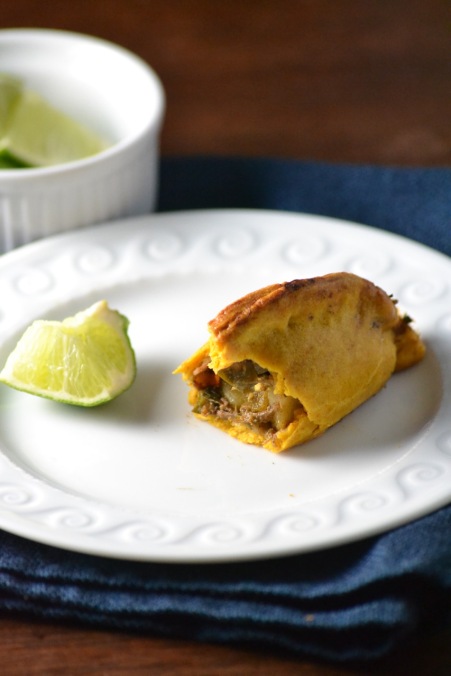
I believe it’s worth the effort to make your own dough for these salteñas (the slight sweetness of the dough provides a tasty complement to the spiced filling), but in a pinch a store-bought pastry dough could be substituted. Happy cooking!
Salteñas de Pollo – Printer Friendly Recipe
Makes about 20 small salteñas
These turnovers are popular all over Bolivia and have infinite variations. Green peas are sometimes added as are manzanilla olives and raisins. I like the addition of 2 hard-boiled eggs, but they are optional as well and subject to personal preference. While these salteñas are mild, add some hot red pepper flakes to heat things up.
The key to a delicious salteña is a moist filling. To achieve this use a very gelatinous stock. The chicken feet used below are for this purpose and ensure that the filling will congeal slightly as it chills making it easier to stuff the salteñas. Upon cooking, the mixture will become moist again.
While traditionally prepared with chicken feet and legs as described below, feel free to substitute different meats such as short ribs, pulled pork, or leftover roasted chicken. For best results, make sure you have at least two cups of meat to add to the filling and if not using homemade broth, reduce the broth added to about 1 ½ cups.
Relleno (Filling):
¾ lbs chicken feet (about 10 feet)
1 ½ lbs chicken legs
¾ lbs Yukon gold potatoes
1 ½ tablespoons canola oil
1 large white onion, finely chopped
½ large red bell pepper, finely chopped (about ½ cup)
4 green onions, roots trimmed, white and green parts thinly sliced
2 garlic cloves, minced
1/3 cup finely chopped fresh flat leaf parsley
1 teaspoon ground cumin
1 teaspoon dried oregano
1 teaspoon ground achiote
¼ teaspoon ground allspice
1 teaspoon salt, more to taste
Freshly ground black pepper, to taste
Hot red pepper flakes, to taste (optional)
2 hard-boiled eggs, chopped
Egg wash
Masa (Dough):
2 teaspoons achiote paste
2 tablespoons hot water
4 cups all purpose flour, more as needed
1 ½ teaspoons baking powder
2 tablespoons granulated sugar
1 ½ teaspoons salt
¾ cup lard (see recipe), vegetable shortening, or cold butter
1 large egg
½ cup water, plus more added in teaspoonfuls if needed
Serve with: Hot sauce, lime wedges
Special equipment: food processor with blade attachment, 4 or 5-inch round cutter
For the filling:
Place the chicken feet and chicken legs in a 4- to 6-quart pot. Cover with cold water (use at least 6 cups of water). Bring to a boil and skim off any foam that accumulates on the surface. Reduce the heat to a low simmer and cook for 1 hour. Remove the chicken legs and set aside to cool. Remove and discard the chicken feet. Strain the stock and reserve 2 cups of it for the filling; any remaining stock can be refrigerated or frozen for later use. Remove and discard the skin from the cooked chicken legs. Shred the meat into small pieces (you should have about two cups of meat) and set aside.
Peel the potatoes and cut them into ½-inch cubes. Place them in a medium pot and cover with cold, lightly salted water. Bring to a boil. Cook the potatoes for 12 minutes until tender. Strain and reserve the potatoes.
Heat a large, high-sided skillet over medium heat. Add the canola oil and then stir in the white onion and red bell pepper. Cook, stirring frequently, until golden brown. Stir in the green onions and garlic and cook for an additional minute. Add the shredded chicken, drained potatoes, the parsley, cumin, oregano, achiote, allspice, salt and pepper and stir to combine. Add the reserved 2 cups chicken broth and bring the mixture to a simmer. Simmer for 10 minutes then remove the filling from the heat. Adjust the seasonings as needed then allow the mixture to cool. Once cool, stir in the chopped hard-boiled eggs and then chill completely in the refrigerator before proceeding to the next step.
For the dough:
Dissolve the achiote paste in the 2 tablespoons of hot water. Set aside. Add the flour, baking powder, sugar and salt to the bowl of a food processor fitted with the blade attachment. Process to combine.
Add the lard to the food processor and pulse until the mixture resembles coarse meal. With the motor running, add the egg and then slowly add the ½ cup water. The dough should come together, but should not be sticky. If needed, add additional water in teaspoonfuls. Remove the dough from the food processor and knead to combine. Cover with a cloth and let rest for 30 minutes.
Assembling:
Preheat the oven to 375 degrees. Line two baking sheets with parchment paper. Divide the dough into two equal portions and lightly dust a work surface. Working with one portion at a time, roll the dough out until it is ¼-inch thick using a pastry brush to brush the dough with flour if it is sticking. Cut out rounds using a 4- or 5-inch round cutter and place them on the prepared baking sheets. Scraps can be gathered and re-rolled an additional time, but let them rest for at least 15 minutes before working with them again. Repeat with the remaining dough until you have about 20 rounds.
In the center of each round, place about 2 tablespoons of filling. Fold the dough up around the filling to form a half-moon shape. Press the edges together to seal the dough around the filling. Crimp decoratively or use a fork to seal the edges. Unlike other turnovers, salteñas stand straight up with the seamed edge facing up.
After all the salteñas have been made, brush them with egg wash and bake for 25 minutes. Remove from the oven and let cool for about 5 minutes before serving with hot sauce and lime wedges.
Unbaked salteñas can be frozen and then cooked (don’t defrost) directly from the freezer. They will require a little extra time to bake. To freeze, place the salteñas on a baking sheet and place in the freezer. Once frozen, remove the salteñas from the baking sheet and place in a plastic bag or storage container.
I can’t wait to make your delicious short ribs myself — and then convert any leftovers to these wonderful pies! Thank you for encouraging me to make substitutions as necessary. I’ve tied on my apron and am rolling up my sleeves now!
LikeLike
Thanks, Suzanne! I appreciate you leaving me with some leftover inspiration. Happy cooking!
LikeLike